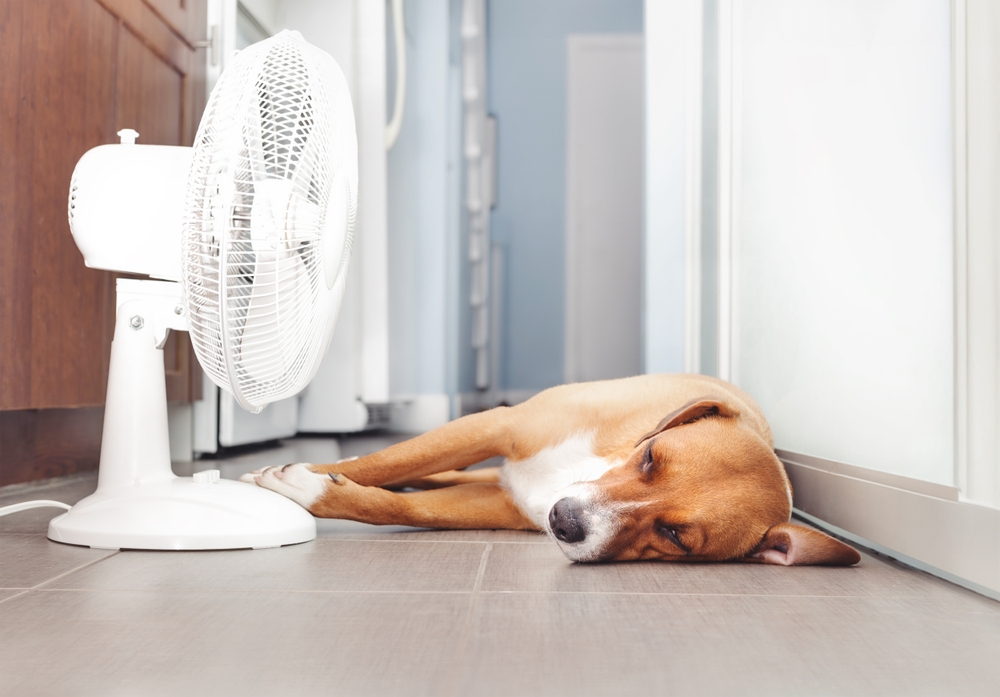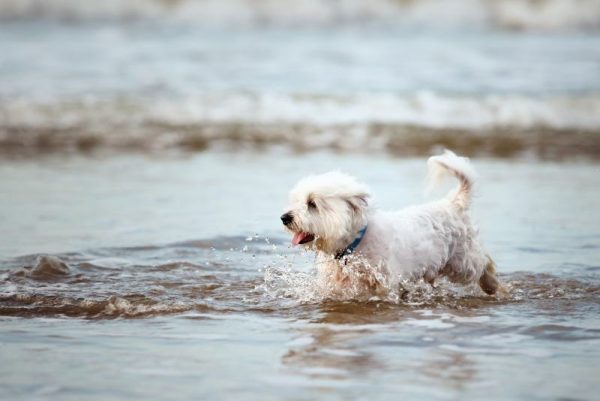As a veterinarian, seeing a dog die from heat stroke despite life-saving efforts is an absolutely devastating event for all parties involved. Because this medical condition can, in many cases be prevented, being aware of this subject could help save your dog’s life.
This article will highlight the causes, signs, and potential treatment of this condition in dogs so that you can either totally prevent it from happening or, if it is already occurring, be aware of what to look for and know the life-saving steps needed.

What Is Heat Stroke?
The normal body temperature of dogs is in the 100–102.5 degrees Fahrenheit (F) range. When a dog’s body is above 105 ℉, this becomes an emergency. Hyperthermia is the medical term for an elevated body temperature above normal. Often, this high body temperature falls within two categories: internal (fever-producing illness) or external causes. Heat stroke is a type of hyperthermia caused by an external source of heat that can occur in the 106–109 ℉ range and occurs when the body is unable to deal with the extra heat. This can then result in widespread organ dysfunction and even death.
A dog’s primary mode of cooling itself is via panting. Unlike humans, who have lots of sweat glands all over their bodies, dogs only have sweat glands in their paw pads. These factors limit their ability to cool themselves as efficiently as human beings can. As a dog’s body becomes overwhelmed and they are unable to adequately cool themselves, their body temperature rises. Eventually, signs of heat stroke can become evident.
In the human world, there are different classifications based on the severity of illness due to heat; these include heat stress, heat cramps, heat exhaustion, and heat stroke. Heat stress and heat cramps are rarely recognized in veterinary medicine, and overall, the dog has a normal body temperature at these stages. Heat exhaustion, on the other hand, can occur with a normal or mildly increased body temperature and may have a manifestation of physical signs such as weakness, difficulty walking, or an inability to continue the activities they were doing.
Finally, the most severe of the group is heat stroke. This condition will have a higher-than-normal body temperature as well as several physical signs (see below) that show that multiple organs are affected. In heat stroke, the systems of the body that are negatively acted upon can include the cardiovascular, pulmonary, renal, gastrointestinal, and central nervous systems as well as the abnormal clotting of blood.

What Are the Signs of Heat Stroke?
Being conscious of the signs of heat stroke is key as fast recognition of the process allows an affected dog to have access to treatment quicker and allows for a better overall prognosis. Below are some common physical signs of heat stroke in a dog that may be observed; they are often seen with many occurring together rather than in isolation.
- Distressed, restless behavior
- Excess panting
- Hypersalivation (Drooling)
- Difficulty breathing, respiratory distress
- Weakness
- Difficult or uncoordinated walking
- Vomiting
- Bloody and/or watery diarrhea
- Mentation changes, depression
- Muscle tremors
- Seizures
- Gums may turn blue, white, or bright red
- Collapse
If you suspect your dog might be suffering from underlying health issues or is experiencing any of these signs, you should contact your vet.
If you need to speak with a vet but can't get to one, head over to PangoVet. It's an online service where you can talk to a vet online and get the personalized advice you need for your pet — all at an affordable price!

What Are the Causes of Heat Stroke?
As mentioned, heat stroke is a type of hyperthermia (raised body temperature) caused by an external heat source, usually the sun. For this to occur, the dog typically must have been present in an environment where the temperature and humidity are such that they overwhelm the body’s heat regulating mechanisms. Most frequently this would be seen in cases where a dog is exposed to high temperatures coupled with a lack of relief from the elements. While this could occur in various situations, it’s typically most common in very warm and/or humid climates. In addition, exertional exercise, especially in those dogs who have not acclimated to a warmer temperature (typically takes between 10 and 20 but up to 60 days) is more likely to have heat stroke than those who are not acclimated.
Other types of heat stroke that could occur at any time of the year include that of inadequate ventilation or excess heating from heating elements. Also playing a role in cases of heat stroke is the limited or restricted accessibility to water
- Being left unattended in a car on a non-cold day (even with the windows cracked)
- Being left outside for long periods of time when it’s hot and sunny without access to shade and water
- Exercising during high temperatures/humidity
- Prolonged drying time after a bath
- Being left on a heating pad for extended periods of time


How Do I Care for a Dog with Heat Stroke?
Before Arriving at a Veterinary Hospital
Heat stroke is an emergency situation and treatment should start even before making it to the veterinary clinic. Surprisingly, in one study, 61% of heatstroke dogs died that were not cooled prior to veterinary presentation versus the death of only 38% of heatstroke dogs that were cooled prior.
- Remove your dog from the hot environment to a cool or shaded area.
- Bonus: if you have the ability to take the dog’s rectal temperature, this can be helpful to know the starting place and progression over time. In addition, it’s important to stop cooling measures when a dog is at about 103 ℉.
- Start the cooling process at once. The goal is to cool them down without over-cooling as shivering and hypothermia are undesirable effects. You can try placing a fan directly on them, placing the dog in a cool bath or shower, or spraying with a hose. Do not place their head underwater. Water that is cold or cool is ideal, but try to avoid ice.
- Make sure there is a constant turnover of cool water as the body heat from the dog will heat the water they are sitting in. This is why a shower is preferred over a bath.
- Wet the ear flaps, armpits, foot pads, and tongue with cool water as well.
- You may offer water if they are alert and interested, but do not force the dog to drink.
- Bring the dog to the nearest open veterinary clinic right away.

At the Veterinary Hospital
Even if you can cool your pet’s temperature down prior to arrival, because a dog with severe hyperthermia is affected in numerous areas of their body, veterinary medical care should still be sought promptly.
Various kinds of bloodwork to determine internal organ damage, types and amount of blood cells present, clotting factors, etc. in addition to urine testing can be very important to determine how severe the damage is as well as what avenues of treatment may need to be added.
Until a dog’s temperature cools to about 103 ℉, other imperative cooling procedures will be implemented. Intravenous (IV) fluids are most often an integral part of the treatment plan. Additional therapy and medications will be based on how a dog presents—some examples would be products to resolve vomiting and/or diarrhea, seizures, heart abnormalities, abnormal blood pressure, brain swelling, etc. Sometimes the affected dog may need oxygen therapy or plasma transfusions.
Temperature checks and continual monitoring with changes to the medical treatment plan as needed are extremely important. An affected dog often will need to be hospitalized until they have a stable temperature and may need fairly intensive care to manage any after effects. This is commonly at least a couple-day venture.
Frequently Asked Questions (FAQ)
What are some risk factors for a dog developing heat stroke?
Heat stroke can occur in any dog, regardless of breed, age, or sex. But there are some predispositions that can make it likely to happen more quickly than a dog that does not have these contributing factors.
- Brachycephalic dogs; short-nosed or flat-faced dogs that often have restrictive airway anatomy such as Pugs, English Bulldogs, Boxers, etc.
- Age (younger or older animals)
- Obesity
- Long or thick hair coat
- Dehydration
- Simultaneous heart and/or lung disease
- Prior episode(s) of heat stroke
- Sudden heat wave with no time to acclimate to increasing environmental temperatures

What are some tips for my dog during hot and/or humid weather?
- Have access to a cool environment that is out of direct sunlight. In warm and humid climates, this is best brought about with air conditioning. Other options may include fans or shade. Keep in mind that as the sun moves throughout the day, the shade may change if a dog is enclosed within an area outside.
- Ensure there is always fresh, cool water available. You can add ice to the water and, depending on the weather, you may need to change out the bowl regularly.
- Make water a part of your dog’s daily warm weather fun.
- Exercise your dog during cooler times of the day. During the warmer months, this may mean early mornings or after dusk are the best times to do this.
- Realize that being confined in a parked car or a doghouse can quickly become a death trap; do not leave your dog in an enclosed vehicle alone if the temperature cannot be controlled. Do not rely on air conditioning in the car as this will automatically shut off after a certain time frame in most cars.
- Dog-cooling products such as dog-cooling mats or vests may also be an option.
- Check the sidewalk or yard temperature before taking your dog for a walk. If it is too hot on the floor to rest the back of your hand on for 7 seconds, then it is too hot to walk your dog on.
What is my dog’s overall prognosis?
This is a difficult question to answer as it will depend on several underlying factors such as how high the dog’s temperature gets, how long they have an elevated temperature, any underlying medical conditions, as well as some of the predispositions listed above. One study found there was about a 50% mortality (death rate).
Considering this information, your best bet is to do everything possible to prevent heat stroke from happening. If it does occur, quick recognition and seeking treatment right away is key. A lag between the precipitating event and treatment can make the prognosis poorer.

Conclusion
Heat stroke is a serious medical problem in dogs. When it occurs, it can be life-threatening, and treating it quickly is imperative. Armed with this knowledge, you can not only be aware of how to prevent this health issue from occurring, but if and when it does take place, the treatment and medical care steps needed right away.
Featured Image Credit: Tienuskin, Shutterstock


















